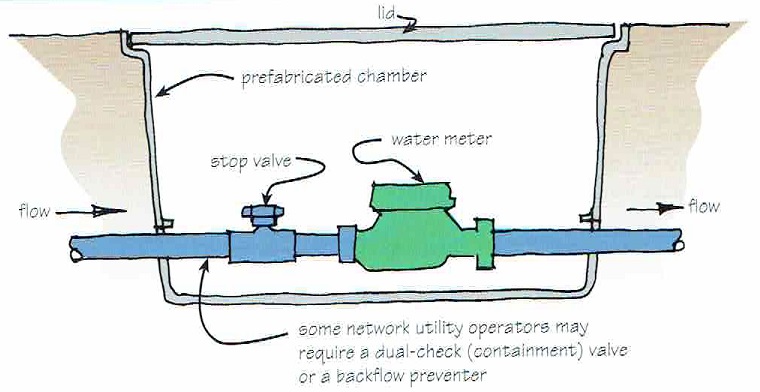To a home or business, the water main is the main artery connecting the building to the primary water supply. This important system components function is conveying water. Working with water mains can be a very lengthy and complex process for inexperienced plumbing contractors. However the plumbers at Local Plumbing And Sewer are experts in all aspects of water main integration, installation and repair.
Working with water mains consists of several steps, including digging a trench, bedding and so on. Below we break down the main steps that we may encounter when working on a water main project.
EXCAVATION
First and foremost the initial step in Water Main Installation is excavation. It is a process where we dig a passage for installing the pipe. A number of factors which we keep in mind before initiating this process are
- Ground frost conditions
- Ground water conditions
- Traffic load that will be over the pipe
- Soil type
- Size of pipe to be installed
- Surface restoration requirement and
- Depth of other utility lines that must be crossed or paralleled by the water main.
TRNCH DEPTH
The depth of a trench depends upon the climate, the size of the pipe, traffic and several other factors.
- In colder regions, severe winter frost can penetrate twice the average winter frost depth. Closed cell Styrofoam insulated board, 2 in. (50mm) thick and 2 to 4 ft (0.6 to 1.2 m) wide is considered fit, if adequate depth is not possible.
- In warmer regions, minimum depth of cover to protect it from any danger is usually 2.5 ft (0.8m) for water main.
TRENCH WIDTH
The width of trench necessary for Water Main Installation is generally governed by the following conditions
- Minimum depth to allow for proper joint assembly and compaction of soil around the pipe
- Safety considerations
- The need to minimize the external loading on the pipe
Trench width below the top of the pipe should generally be not more than 1 to2ft (0.3 to 0.6 m) greater than the outside diameter of the pipe. The width provides enough space to workers for installing. Wide trenches should be avoided in small diameter pipes, especially in hard clay soils.
BEDDING
Bedding means preparing a platform for placing the pipes (PVC). Few things while bedding should be kept in mind.
- Bottom of the trench must be properly leveled and compacted so that the barrel of the pipe will have continuous, firm support along its full length.
- Leveling board should be used to ensure that there are no voids and high spots and that the grade is correct.
- In adverse soil situations (damp soil or solid rocks), special pipe bedding may be specified by the engineers. A clean, well graded granular materialupto1 in (25mm) in size. It should contain no lumps or frozen ground and have no more than 12% of clay and silt that can be sensitive to water.
- When natural trench bedding is unable to support the pipe, it is necessary to dig another 12 to 24 in (300 to 600 mm) deeper.
- Haunching is a process of placing bedding material around the haunch of a pipe. It is necessary for increasing the load bearing capacity of the pipe.
LAYING PIPE
Once the trench is ready, the pipe may be placed into position. There are several general directions for laying pipe.
- Inspection- A pipe should be inspected for damage. Any unsatisfactory section should be removed.
- Cleaning- Dirt, oil, grease, animals or any other foreign material should be removed before installation. The hypo chloride solution is recommended for quick and proper cleaning
- Placement- The pipe should not be rolled, it should be lowered into the trench by hand or mechanical equipment
- While placing, pipe is usually supported by a sling in the middle
- Installers should make a conscious effort to keep the inside of pipe clean during lying.
JOINING PIPE
This is a sensitive part of the Water Main Installation process. It must be done correctly to minimize leakage and ensure proper functionality and longevity for the water main service. Methods of joining, depends upon the type of pipe material and type of the joints. Bell holes must be dug by hand where pipes will be jointed. This will allow room for the joint to be installed. The size of the bell hole will vary with the type of pipe and joint used. Too large bell holes can create stress on the pipe.
PUSH ON JOINTS
The four general steps in making up ductile iron or PVC pipes push on joints are:
- Clean the groove and bell socket of the pipe.
- Apply lubricant to the gasket and plain and of the pipe.
- Plain and should be beveled, sharp edges may damage or dislodge the gasket.
- Small pipe can be pushed into bell socket with a long bar. A timber header should be used between the pipe and backhoe bucket to avoid damage to the pipe.
CONNECTING TO EXISTING MAINS
There are two possible ways to connect with existing mains. Installer can connect either by a new tee or by making a pressure tap.
- TEE CONNECTIONS
A tee fitting is inserted in existing mains. Existing mains must be out of connection for several hours. A piece of main is to make a cut or snap at the outside edges of the section to be removed. Then a third cut is made midway between them. When the pipe is hit with a sledge in the center, it will easily break out
- PRESSURE TAPS
Pressure taps are highly recommended and used because of their advantages. Few of the advantages are following-
- Customers are not inconvenienced by having their water turned off
- Lower probability of contaminating the water system
- Fire protection in the area remains in service
- No water loss
- Based on the time required to close valves and notify customers before inserting a tee is taken into account making a pressure tap is much faster.
Once the excavation has been prepared, a pressure tap is completed in following steps:
- The surface of the existing main is cleaned. The tapping sleeve is installed on the main, with the face of the flange vertical.
- The special tapping valve is attached to the sleeve’s projecting flange.
- The tapping machine is installed on the valve, with the shell cutter attached. The machine is supported on contemporary blocks.
- With the tapping valve open, the cutter is advanced to cut a hole in the main.
- The cutter is retracted to beyond the valve, and the valve is closed.
- The tapping machine is removed, and the new main is connected.
This is the basic overview of what we encounter during the process of working with a Water Main Installation project. Due to the complexity of these projects, it is important to utilize a licensed, insured & experienced plumbing contractor for any jobs where there is a water main installation, water main repair or water main integration. Local Plumbing And Sewer is familiar with all aspects of water main projects and has been working with local water companies for 8+ years. Let us provide all your water main related services for your home or business!


